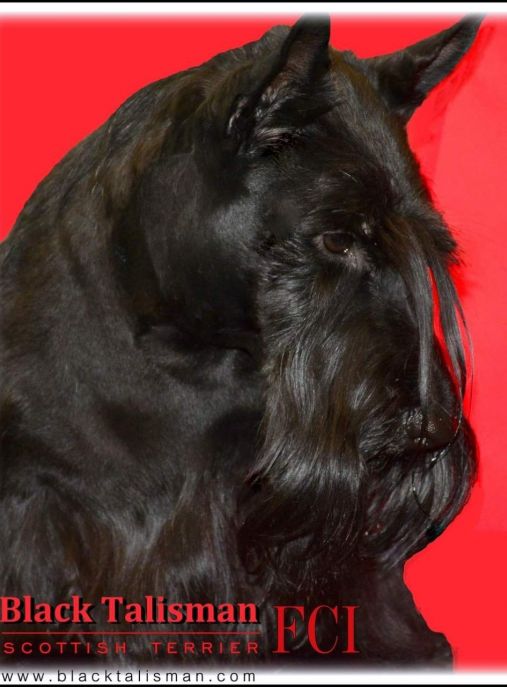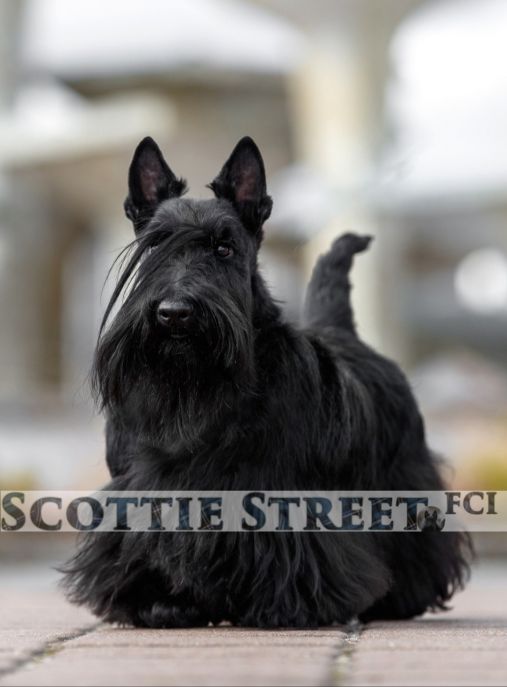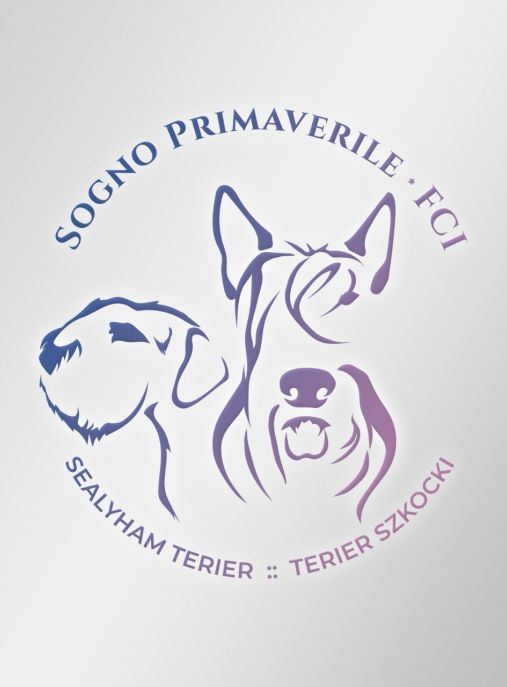The Scottish Terrier, also known as the Scottie, is a small and sturdy dog breed that originated in Scotland. With its distinctive appearance and charming personality, the Scottish Terrier has become a beloved companion and show dog around the world. This breed is known for its unique physical features, rich history, and loyal nature.
The history of the Scottish Terrier dates back several centuries. It is believed that the breed's ancestors can be traced back to the Scottish Highlands, where they were used as working dogs for hunting small game, such as rats and foxes. Their compact size, strong build, and sharp instincts made them excellent hunters, and they were highly valued for their ability to keep farms and households free from vermin.
According to the FCI (Fédération Cynologique Internationale) typology, the Scottish Terrier belongs to Group 3 - Terriers. This group includes various terrier breeds that share common characteristics such as courage, tenacity, and a strong prey drive. Within this group, the Scottish Terrier is classified under Section 2 - Small-sized Terriers.
Scottish Terriers are primarily bred as companion dogs and are cherished for their loyalty and affectionate nature. They form strong bonds with their families and are known to be protective and devoted. Despite their small size, they possess a confident and independent personality, which adds to their charm.
In terms of physical attributes, the Scottish Terrier is a compact and muscular breed. They have a sturdy build with a deep chest and a well-developed head. Their distinctive features include a long, strong muzzle, erect ears, and a dense, wiry double coat that comes in various colors, including black, brindle, and wheaten. Their expressive eyes and bushy eyebrows give them a unique and somewhat serious expression.
The average weight of a Scottish Terrier ranges between 18 to 22 pounds (8 to 10 kilograms), with males typically being slightly larger than females. In terms of height, they stand at around 10 inches (25 centimeters) at the shoulder. Despite their small size, Scottish Terriers are known for their strength and agility.
The life expectancy of a Scottish Terrier is typically between 11 to 13 years, although some individuals have been known to live longer with proper care. Like many other small dog breeds, Scottish Terriers are prone to certain health issues, including genetic conditions such as Scottie Cramp, von Willebrand's disease, and various skin disorders. Regular veterinary check-ups and a balanced diet are essential to ensure their overall well-being.
Scottish Terriers have a few interesting facts associated with their breed. They are known for their distinctive bark, which is often described as a deep, resonant sound. This bark is a part of their protective nature and their tendency to alert their owners of any potential threats. Additionally, Scottish Terriers have a strong prey drive, which can make them inclined to chase small animals or exhibit stubborn behavior. Early socialization and training are crucial to ensure they develop good manners and are well-behaved members of the family.
In conclusion, the Scottish Terrier is a remarkable breed with a rich history and unique characteristics. Their compact size, sturdy build, and loyal nature make them excellent companions for individuals and families alike. Whether as a show dog or a beloved pet, the Scottish Terrier continues to capture the hearts of dog enthusiasts worldwide.
The Scottish Terrier, also known as the Scottie, is a small but mighty breed that possesses a unique and captivating character. With their distinctive appearance and spirited personality, Scotties have become a beloved breed among dog enthusiasts worldwide. Let's delve into the fascinating world of Scottish Terriers and explore their character, behavior, and how to raise and train them.
Scottish Terriers are known for their strong-willed and independent nature. They exude confidence and possess a sense of self-importance, often carrying themselves with an air of dignity. Despite their small stature, Scotties have a fearless and determined spirit, making them excellent watchdogs. Their alertness and tendency to bark at unfamiliar sounds or visitors make them reliable guardians of their homes.
While Scotties are generally friendly and affectionate with their families, they can be reserved and aloof with strangers. This reserved nature stems from their inherent loyalty and protective instincts. However, early socialization is crucial to ensure they grow up to be well-rounded and accepting of new people and situations.
Scottish Terriers are known to be intelligent and quick learners, but they also possess a stubborn streak. This stubbornness can make training a challenge at times, requiring patience, consistency, and positive reinforcement techniques. It is important to establish yourself as the pack leader from an early age to prevent any dominance issues. With the right approach, Scotties can excel in obedience training and even participate in various dog sports.
Exercise is essential for the physical and mental well-being of Scottish Terriers. Despite their small size, they have moderate energy levels and require daily walks and playtime. Engaging them in mentally stimulating activities, such as puzzle toys or obedience training sessions, can help channel their intelligence and prevent boredom.
Scotties have a strong prey drive, which can make them prone to chasing small animals. Therefore, it is crucial to keep them on a leash or in a securely fenced area during outdoor activities. Additionally, their thick double coat requires regular grooming to keep it healthy and free from mats. Brushing their coat a few times a week and regular professional grooming sessions will help maintain their iconic appearance.
As with any dog, early socialization and positive reinforcement training are vital for Scottish Terriers. Exposing them to various people, animals, and environments from a young age will help them develop into well-adjusted and confident adults. Consistency, patience, and a firm yet gentle approach are key to successfully raising and training a Scottie.
In conclusion, Scottish Terriers are charismatic and independent dogs with a unique character. Their loyalty, intelligence, and spirited nature make them wonderful companions for the right owner. While they may present training challenges due to their stubbornness, with the right techniques and approach, they can become well-behaved and obedient pets. By providing them with proper exercise, grooming, and socialization, you can ensure that your Scottish Terrier thrives and brings joy to your life for many years to come.
The Scottish Terrier, also known as the Scottie, is a small and sturdy breed that requires specific care to ensure their health and happiness. Here is an extensive description of the recommended care for Scottish Terrier dogs, including tips on what to do and what not to do:
1. Grooming:
Scotties have a dense double coat that requires regular grooming. Brush their coat at least once or twice a week to prevent matting and remove loose hair. Regular brushing also helps distribute natural oils and keeps their skin healthy. Trim their nails regularly, clean their ears weekly, and brush their teeth daily to maintain good oral hygiene.
2. Exercise:
Scotties are energetic dogs that need regular exercise to stay fit and mentally stimulated. Take them for daily walks or play sessions in a securely fenced yard. Engage them in interactive games and provide them with toys that challenge their intelligence. However, avoid excessive exercise in extreme weather conditions as they are prone to overheating.
3. Training and Socialization:
Start training your Scottish Terrier from an early age to establish good behavior and obedience. They are intelligent but can be stubborn, so use positive reinforcement techniques like treats and praise. Socialize them with other dogs, animals, and people to prevent them from becoming overly protective or aggressive.
4. Diet and Nutrition:
Provide a well-balanced diet that meets the nutritional needs of your Scottie. Feed them high-quality dog food formulated for small breeds. Avoid overfeeding as Scotties are prone to weight gain, which can lead to various health issues. Consult your veterinarian to determine the appropriate portion sizes and feeding schedule for your dog.
5. Health Care:
Regular veterinary check-ups are crucial for maintaining your Scottie's health. Vaccinations, parasite prevention, and dental care should be a part of their routine healthcare. Scottish Terriers are prone to certain health conditions like Scottie Cramp, Von Willebrand's disease, and skin allergies. Be aware of these potential issues and seek immediate veterinary attention if you notice any abnormalities.
6. Climate Considerations:
Scotties have a low tolerance for heat and humidity due to their dense coat and short snouts. Ensure they have access to shade, fresh water, and a cool environment during hot weather. In colder climates, provide them with warm bedding and protect them from extreme cold temperatures.
7. Avoid Overexposure to Chemicals:
Scotties have sensitive skin, so avoid using harsh chemicals or strong flea and tick products that may cause skin irritations. Opt for gentle grooming products specifically designed for dogs and consult your veterinarian for safe parasite prevention options.
8. Mental Stimulation:
Scotties are intelligent dogs that thrive on mental stimulation. Provide them with puzzle toys, interactive games, and training sessions to keep their minds engaged. Mental stimulation helps prevent boredom and destructive behaviors.
9. Avoid Rough Play:
Scotties have a strong prey drive and can be possessive of their toys or food. Avoid rough play that may trigger their aggressive instincts. Teach children and visitors to respect their boundaries and not to disturb them while eating or sleeping.
10. Love and Affection:
Scottish Terriers are loyal and affectionate companions. Provide them with plenty of love, attention, and quality time. They thrive on human companionship and may develop separation anxiety if left alone for long periods. Make them a part of your family and include them in your daily activities.
Remember, each Scottish Terrier is unique, and their care may vary based on their individual needs. By following these general guidelines and consulting with your veterinarian, you can ensure that your Scottie leads a healthy and fulfilling life.
The Scottish Terrier, also known as the Scottie, is a small and sturdy breed that is instantly recognizable by its distinctive appearance. One of the defining characteristics of this breed is its unique coat color, which adds to its charm and allure. Scottish Terriers come in a variety of colors, but the most common and iconic color is black.
The black coat of a Scottish Terrier is often described as jet black, giving it a sleek and glossy appearance. It is a dense and wiry double coat that provides protection against harsh weather conditions. The outer coat is rough and hard, while the undercoat is soft and dense. This combination of textures gives the coat its characteristic look and feel.
The black color of the Scottish Terrier's coat is usually uniform throughout the body, with no markings or patterns. However, some dogs may have a small patch of white on the chest, which is considered acceptable within breed standards. This white patch, if present, adds a touch of contrast to the overall black coat.
The black coat of a Scottish Terrier not only contributes to its aesthetic appeal but also serves a practical purpose. It helps the dog blend into its surroundings, making it an excellent hunter and tracker. This coloration allows the Scottie to move stealthily and go unnoticed, which was particularly advantageous during its early days as a working dog.
In addition to its striking black coat, the Scottish Terrier has other physical features that enhance its overall appearance. It has a well-proportioned body with a strong and muscular build. Its head is adorned with a thick mane of hair, which adds to its regal and dignified expression. The ears are erect and pointed, giving the dog an alert and attentive look.
Maintaining the black coat of a Scottish Terrier requires regular grooming. The wiry texture of the hair means that it does not shed excessively, but it does require brushing to prevent matting and tangling. Occasional hand-stripping, a process of removing dead hair by hand, is also necessary to maintain the coat's texture and appearance.
In conclusion, the common color of Scottish Terrier dogs is black. This jet black coat is a defining characteristic of the breed and adds to its overall charm and elegance. The black coloration not only enhances the dog's appearance but also serves a practical purpose in its role as a hunter and tracker. With its sleek and glossy coat, the Scottish Terrier stands out as a truly remarkable breed.
The Scottish Terrier, also known as the Scottie, is a small and sturdy breed that is known for its distinctive appearance and spirited personality. While generally a healthy breed, Scottish Terriers are prone to certain health issues that owners should be aware of to ensure their furry companions live long and happy lives.
One of the most common health concerns in Scottish Terriers is Scottie Cramp, a neuromuscular disorder that affects the dog's coordination and muscle control. This condition typically manifests as episodes of muscle stiffness or weakness, often triggered by excitement or exercise. While Scottie Cramp is not life-threatening, it can significantly impact the dog's quality of life. Fortunately, most Scotties affected by this condition can still lead relatively normal lives with proper management and care.
Another health issue commonly seen in Scottish Terriers is Von Willebrand's Disease (VWD), a bleeding disorder caused by a deficiency in a specific blood clotting protein. Dogs with VWD may experience prolonged bleeding after injuries or surgeries, and in severe cases, spontaneous bleeding can occur. It is crucial for Scottie owners to be aware of this condition and inform veterinarians before any surgical procedures to ensure appropriate precautions are taken.
Scottish Terriers are also prone to a variety of skin conditions, including allergies, dermatitis, and hot spots. These can cause itching, redness, hair loss, and discomfort for the dog. Regular grooming, including brushing the coat to prevent matting and checking for any signs of skin irritation, is essential. Additionally, a balanced diet and avoiding potential allergens can help minimize the occurrence of skin issues in Scottish Terriers.
Like many small breeds, Scottish Terriers are also susceptible to dental problems. Their small mouths can lead to overcrowding of teeth, which increases the risk of dental disease such as tartar buildup, gum inflammation, and tooth decay. Regular dental care, including brushing the dog's teeth, providing dental chews, and scheduling professional cleanings, is crucial to maintain good oral health.
To ensure the overall well-being of Scottish Terriers, regular exercise is essential. Despite their small size, Scotties have a moderate energy level and require daily walks or playtime to keep them mentally and physically stimulated. However, it is important to avoid excessive exercise, especially in warm weather, as Scottish Terriers are prone to heat sensitivity.
Proper nutrition is also vital for the health of Scottish Terriers. A high-quality, balanced diet that meets their specific nutritional needs is recommended. Overfeeding should be avoided to prevent obesity, which can lead to various health issues, including joint problems and heart disease.
Regular veterinary check-ups are crucial for Scottish Terriers to detect any potential health issues early on. Vaccinations, parasite prevention, and routine screenings for conditions such as hip dysplasia, eye problems, and liver disease should be a part of their healthcare regimen.
In conclusion, while Scottish Terriers are generally healthy dogs, they are prone to certain conditions such as Scottie Cramp, Von Willebrand's Disease, skin problems, dental issues, and heat sensitivity. By providing proper care, including regular exercise, a balanced diet, grooming, dental care, and veterinary check-ups, owners can ensure the well-being and longevity of their beloved Scottish Terriers.
The Scottish Terrier, also known as the Scottie, is a small and sturdy breed that requires a well-balanced and nutritious diet to maintain optimal health. Proper nutrition plays a crucial role in their overall well-being, energy levels, and longevity. In this text, we will delve into the nutritional needs of Scottish Terriers and provide advice on feeding them.
First and foremost, it is important to choose high-quality dog food that is specifically formulated for small breeds. Look for a brand that uses real meat as the primary ingredient, as this will provide the necessary protein for muscle development and maintenance. Avoid foods that contain fillers, by-products, or artificial additives, as these can be detrimental to your Scottie's health.
Scottish Terriers require a diet that is rich in protein, moderate in fat, and low in carbohydrates. Protein is essential for their growth, muscle maintenance, and overall health. Aim for a minimum of 25% protein content in their food. Good sources of protein include chicken, turkey, beef, and fish. However, be cautious with fish, as some types may contain high levels of mercury, which can be harmful to dogs. Consult with your veterinarian to determine the best protein sources for your Scottie.
While fat is an important energy source, it should be provided in moderation to prevent obesity. Scottish Terriers are prone to weight gain, which can lead to various health issues. Look for dog food that contains around 10-15% fat content. Healthy fat sources include fish oil, flaxseed oil, and chicken fat.
Carbohydrates should make up a smaller portion of your Scottie's diet. Opt for complex carbohydrates such as whole grains, sweet potatoes, and vegetables. These provide essential fiber, vitamins, and minerals. Avoid foods that contain excessive amounts of grains or fillers, as they can lead to digestive issues and allergies in some dogs.
Feeding frequency is another important aspect to consider. Scottish Terriers generally do well with two meals per day. Split their daily recommended food portion into two equal meals to prevent overeating and aid digestion. Avoid free-feeding, as it can contribute to weight gain.
In addition to a balanced diet, fresh water should always be available for your Scottie. Hydration is crucial for their overall health and well-being. Ensure that their water bowl is clean and filled with fresh water at all times.
While providing a nutritious diet is essential, it is equally important to avoid certain foods that can be harmful to Scottish Terriers. Some foods that should be avoided include chocolate, caffeine, grapes, raisins, onions, garlic, and foods high in sodium or artificial sweeteners. These can be toxic to dogs and may cause serious health issues.
Lastly, regular visits to the veterinarian are crucial to monitor your Scottie's overall health and nutritional needs. Your vet can provide specific dietary recommendations based on your dog's age, weight, and any existing health conditions.
In conclusion, Scottish Terriers thrive on a well-balanced diet that is rich in protein, moderate in fat, and low in carbohydrates. Choose high-quality dog food, avoid fillers and artificial additives, and provide fresh water at all times. Feed them twice a day, monitor their weight, and avoid harmful foods. By following these guidelines and consulting with your veterinarian, you can ensure that your Scottish Terrier remains healthy, happy, and full of vitality.


















